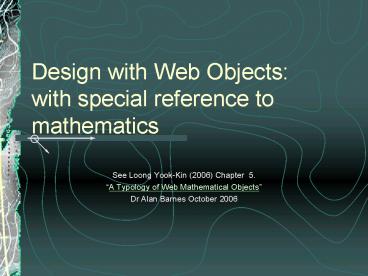Design with Web Objects: with special reference to mathematics - PowerPoint PPT Presentation
1 / 18
Title:
Design with Web Objects: with special reference to mathematics
Description:
Learning Object is key term to characterise the computer program ... See the clickable links in the word version of Ch 5. Design considerations for web objects ... – PowerPoint PPT presentation
Number of Views:58
Avg rating:3.0/5.0
Title: Design with Web Objects: with special reference to mathematics
1
Design with Web Objectswith special reference
to mathematics
- See Loong Yook-Kin (2006) Chapter 5.
- A Typology of Web Mathematical Objects
- Dr Alan Barnes October 2006
2
Rationale of this topic
- As traditional learning is displaced by elearning
we need new vocabulary to express the new
pedagogies. - Learning Object is key term to characterise the
computer program that supports a learning
experience. - Web learning objects are learning objects that
run within a web browser - As specific learning areas have some associated
specific softwarewe will use Mathematics to
express relevant properties of web
objects-students are welcome to conceive of
similar properties for their own learning area.
3
What is a web learning object?
- A piece of integrated web functionality that
supports a learning experience - A collection of web pages
- A web page
- A part of a web page
- A javascript/flash/etc. program running in a
window on a web page
4
Software for Mathematics
- Exploratory Worlds-Geometers sketchpad
- Simulations-
- Symbolic Systems-Mathematica, Derive, MathCad
- Writing Systems-Mathtype,Milo
- Numerical Systems-Spreadsheets, Calculators
5
Traditional teaching practices
- Explanations, demonstrations lectures
- Practice and problem solving
- Tests
- Group work and peer support
- Authentic studies and games
- Homework management
- Expert advice
- Inquiry Learning
6
Traditional physical resources
- Text books with explanations, worked examples,
diagrams, practice problems(with answers). - Practice problems kept in exercise books
- Teachers or student notes
- Problem sheets often drawn from texts
- Tools calculators protractors, rulers
7
Expressed Pedagogies of Web Objects Developers
- self paced, independent learning
- Math Cats existing in a teacherless world where
kids take charge of their own education. In that
world, it is really up to them how to use Math
Cats. (Math Cats) - developing mathematical thinking
- students able to work mathematically with group
work, visualization, physical involvement and
estimation . . . a philosophy that students are
learning to work like a mathematician. (Maths300) - engaging students in interactive activities that
enable the understanding of different
mathematical concepts - Ref Ch5.1g
8
Maths Objects?
- active diagrams
- calculators
- problem sets
- puzzles
- Interactive charts
9
Web Maths Objects
10
Activity Maths on the Web
- Examine the Ray Hall Turbocharging site What
mathematics could you teach with this site? - The gorgeous MathsCats http//www.mathcats.com/c
ontents.html - Some well crafted materials at Mrs Glossers
Maths Goodies - http//www.mathgoodies.com/ eg. Java enabled
puzzles http//www.mathgoodies.com/puzzles2004/ - Wonderful little factor tree manipulative at
- http//matti.usu.edu/nlvm/nav/framtrees_asid_202_
g_4_t_1.html - Beautiful Platonic solids(drag and rotate)
- http//www-sfb288.math.tu-berlin.de/vgp/content/so
lids/PaPlatonic.
11
- Pedagogy with web objects
12
Teacher Strategies with Web Objects
- Expositive
- Active
- Collaborative
- Consolidative
13
When to use Web Objects
- Active diagrams replace book diagrams
- Basic principles can be explored and discovered
- Interactive experiences using multiple modalities
- Extensive problem sets
- Drill for those needing practice
- Extension for the accelerated
14
Task-Object Pedagogy
- Blending traditional learning and elearning
- Replace some tasks with web objects use
- Teacher retains control of context and sequence
- Text book remains a primary guiding resource
15
See the clickable links in the word version of Ch
5.
16
Design considerations for web objects
- Perception and attention
- detail, sound, colour, visuals
- Memory
- organisation or repetition
- Comprehension
- interpretation and integration
- Active learning
- interactivity
17
Further considerations
- Motivation
- relevance, challenged, control, satisfaction
- Locus of control
- control over instruction, methodology, content
- Transfer of learning
- affected by type, amount, and variety of
interaction - Individualisation
18
References
Loong Yook-Kin (2006) Chapter 5. A Typology of
Web Mathematical Objects in Web Based teaching
Strategies for Secondary School Mathematics PhD
Thesis University of South Australia 2006































